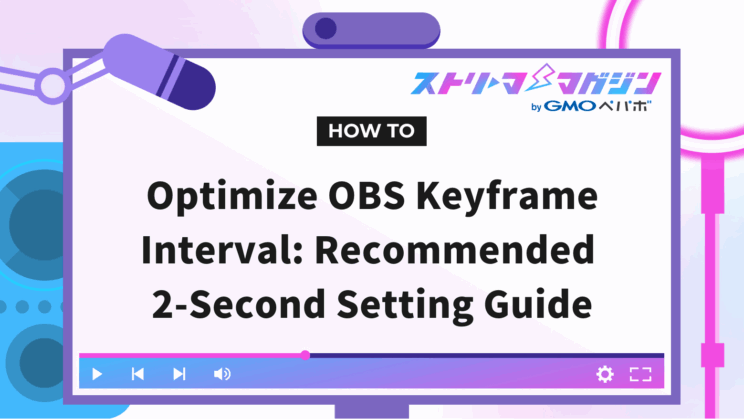Optimize OBS Keyframe Interval: Recommended 2-Second Setting Guide

Index
- What is OBS’s Keyframe Interval?
- [OBS] How to Set and Change Keyframe Interval | “2 Seconds” Recommended
- Recommended Keyframe Interval for Each Streaming Service [OBS]
- Points to Consider When Changing Keyframe Interval in OBS
- Important Settings Other Than Keyframe Interval for High-quality Recording with OBS
- Summary
“I want to set the keyframe interval in OBS, but I’m not sure which number is optimal…” Many of you probably have this concern.
In conclusion, the basic setting for the keyframe interval in OBS is “2 seconds.” It is recommended by many streaming services and is considered the best setting to maintain stable image quality.
This article will explain in detail what OBS’s keyframe interval is and how to set it. We will also introduce recommended settings for various streaming services such as Twitch and YouTube LIVE, as well as tips for maintaining high image quality during recordings.
By reading this article, you’ll understand how to optimally set the keyframe interval in OBS, and you’ll be able to enhance the quality of your streams and recordings to deliver comfortable visuals to your viewers.
Be sure to read to the end.
What is OBS’s Keyframe Interval?
The keyframe interval in OBS Studio refers to the setting that indicates how frequently complete frames (keyframes) are inserted in video streaming and recording.
Regular videos only record differences between frames, but keyframes are stored as they are, affecting video stability.
Shorter intervals tend to stabilize image quality but increase data size. Conversely, too long intervals can lead to video distortion, so it’s important to set an appropriate interval based on the purpose and environment of the stream.
[OBS] How to Set and Change Keyframe Interval | “2 Seconds” Recommended
Here’s how to set and change the keyframe interval in OBS.
It is recommended to set the keyframe interval to “2 seconds.” However, since recommended values may differ depending on the streaming platform, it’s essential to check beforehand and set appropriately.
- Launch OBS and open the settings screen
- Click the “Output” button
- Set the keyframe interval to “2 seconds”
Let’s take a look at each one.
Launch OBS and Open the Settings Screen
First, launch OBS Studio and click the “Settings” button in the lower right corner of the screen.
Click the “Output” Button
Once the settings screen opens, click “Output” from the menu on the left. Make sure the “Output Mode” is set to “Advanced,” and if it’s “Simple,” change it to “Advanced.”
Set the Keyframe Interval to “2 Seconds”
Enter “2” in the “Keyframe Interval (0=Auto)” field within the “Encoder Settings.” Then, click the “Apply” button in the lower-left corner and click “OK” to complete the setting.
Recommended Keyframe Interval for Each Streaming Service [OBS]
The recommended keyframe interval may vary slightly depending on the streaming platform. However, many major services in Japan and abroad recommend “2 seconds,” with platforms like YouTube LIVE allowing up to 4 seconds, providing a certain flexibility.
Below is a table summarizing the recommended keyframe intervals for each service, so please adjust according to the platform you are using.
| Streaming Service | Recommended Keyframe Interval |
|---|---|
| Twitch | 2 seconds |
| YouTube LIVE | 2 seconds (up to 4 seconds allowed) |
| Nico Nico Live | 2 seconds (official recommended value not disclosed) |
| TwitCasting | 2 seconds |
| Mirrativ | 2 seconds |
Let’s take a closer look at each.
Twitch
Twitch officially recommends a keyframe interval of “2 seconds.” Especially for streaming FPS or action games, which involve intense movements, setting short intervals (around 2 seconds) can reduce image distortions and delay issues.
For those who want to know how to stream on Twitch using OBS, be sure to check the following article.
How to Stream on Twitch Using OBS: The Complete Guide from Setup to Going Live
YouTube LIVE
YouTube LIVE officially recommends a keyframe interval of “2 seconds.”
However, it allows up to 4 seconds, so adjusting to 3-4 seconds depending on network conditions can prevent streaming from being interrupted. For a stable stream, keep the keyframe interval under 4 seconds in OBS.
Nico Nico Live
Nico Nico Live does not disclose its official recommended values. However, many streamers set it at 2 seconds, with reports suggesting stability at this setting. If you feel the load is high due to bitrate or resolution, use 2 seconds as a base and make adjustments for optimum performance.
TwitCasting
TwitCasting recommends a keyframe interval of “2 seconds” according to its official guidelines. While it’s a platform for game commentary and chatting, first setting it to 2 seconds is a safe approach, particularly given potential image distortion due to different network conditions.
Mirrativ
Mirrativ, primarily a mobile streaming platform, also officially recommends a “2 second” keyframe interval for PC streaming. Even if you are casually streaming fast-paced games on your smartphone, setting the keyframe interval at 2 seconds can prevent visual disruptions.
Points to Consider When Changing Keyframe Interval in OBS
When changing the keyframe interval in OBS, consider the following three points:
- Understand the recommended values for each streaming platform
- Adjust according to the content being streamed
- Balance with other OBS settings
Let’s look at each point in detail.
Understand the Recommended Values for Each Streaming Platform
Ignoring platform-recommended settings (such as bitrate and keyframe interval) increases the risk of stuttering streams or degraded image quality.
If platforms like Twitch and YouTube LIVE recommend 2 seconds, it’s optimal to follow those guidelines. For platforms like Nico Nico Live where the official site is not disclosed, 2 seconds is still a prevalent choice and proven effective, so starting with 2 seconds should be fine.
Adjust According to the Content Being Streamed
The keyframe interval is also influenced by the intensity of movement in the streamed content. Games with high movement like FPS or action games benefit from a shorter interval to stabilize image quality.
On the other hand, for content with less movement, like talk shows or slide shows, intervals of about 3-4 seconds may not pose a significant issue.
However, intervals longer than 4 seconds might cause video degradation in some viewing environments, so caution is advisable. Start with 2 seconds and make minor adjustments based on the content.
Balance with Other OBS Settings
Setting only the keyframe interval correctly doesn’t solve all issues related to high quality and stable streaming. Other factors such as bitrate, resolution, frame rate, and encoder settings (CPU or GPU, etc.) are also crucial.
For instance, maintaining a high resolution or FPS with a low bitrate can result in blocky images. Moreover, a slow internet connection will lead viewers to experience lag and stuttering even if the bitrate is high.
Adjust OBS settings carefully while considering balance.
Important Settings Other Than Keyframe Interval for High-quality Recording with OBS
Even in recording with OBS, the keyframe interval is an important setting, but there are also other factors that influence image quality and stability as follows:
- Bitrate
- Audio Bitrate
- Resolution
- Frame Rate (FPS)
- Audio Encoder
- Video Encoder
- Rate Control
- CPU Usage Preset
- Profile
- Multipass Mode
By appropriately adjusting them, you can achieve high-quality recordings. Let’s take a closer look at each.
Bitrate
| Resolution | Frame Rate | Recommended Bitrate (Approximate) |
|---|---|---|
| 720p | 30fps | 2,500–4,000 kbps |
| 720p | 60fps | 3,000–5,000 kbps |
| 1,080p | 30fps | 4,000–6,000 kbps |
| 1,080p | 60fps | 6,000–9,000 kbps |
| 1,440p | 60fps | 9,000–13,000 kbps |
| 4K | 60fps | 20,000–51,000 kbps |
Bitrate is a significant aspect of your OBS recording settings that affects both the quality and file size. For full HD (1,920×1,080) recordings, aim for a bitrate above 6,000 kbps.
During streaming, use CBR (constant bitrate), and for recording, prioritize quality with CQP or CRF modes, resulting in a higher bitrate setting.
If you’d like to learn more about recommended bitrate settings for streaming or recording with OBS, be sure to check out the article below.
Recommended Bitrate Settings for OBS: A Clear Guide for Streaming and Recording
Audio Bitrate
| Usage | Recommended Audio Bitrate |
|---|---|
| Talk/Conversation Focused | 96–128 kbps |
| Game Streaming (With BGM) | 128–192 kbps |
| Music Streaming (Singing/Instrumental) | 192–320 kbps (High Quality) |
Audio bitrate also affects the quality of streaming or recorded sound. Aim around 128 kbps during streaming, while setups involving high-quality audio recommend 192 kbps or more.
Depending on the use and platform, selecting up to 320 kbps is possible. Therefore, for music or singing streams where audio quality matters, consider higher settings.
Resolution
| Usage | Recommended Resolution |
|---|---|
| Game Streaming | 1,920×1,080 (1,080p) |
| Talk Streaming | 1,280×720 (720p) |
| Music Streaming | 1,280×720 (720p) |
Resolution is directly linked to image quality and an essential component of OBS’s streaming or recording settings. However, higher resolutions place greater strain on PCs and networks, necessitating environment-appropriate configuration.
Generally, game streaming is recommended at 1,920×1,080 (1,080p), but if lacking confidence in your PC’s specifications, lowering to 720p for stability is advisable.
Frame Rate (FPS)
| Usage | Recommended Frame Rate |
|---|---|
| Talk Streaming | 30fps |
| General Game Streaming | 30–60fps |
| FPS/Action Game Streaming | 60fps |
FPS (Frames Per Second) directly influences the smoothness of video. Ideally, game or sports streaming requires 60fps, while talk streams typically suffice with 30fps.
Consult your PC’s GPU performance and internet speed before deciding. Where high load is a concern, setting it to 30fps makes stable streaming or recording more manageable.
Audio Encoder
| Audio Encoder | Characteristics |
|---|---|
| FFmpeg AAC | Standard encoder. High quality without issues. |
| CoreAudio AAC | Superior sound quality, made by Apple. |
In OBS, AAC is the main audio encoder available, either standard FFmpeg AAC or CoreAudio AAC upon installation.
CoreAudio AAC offers higher sound quality and is widely used in Apple products. Consider this option if sound quality is a priority.
If you’re looking to dive deeper into OBS encoder settings, be sure to check out the article below.
OBS Encoder Settings Guide: How to Optimize for High-Quality Streaming and Recording
Video Encoder
| Video Encoder | Characteristics |
|---|---|
| x264 (CPU) | Higher quality, but high CPU load. |
| NVENC H.264 (GPU) | Low CPU load, good quality. |
| QuickSync (GPU) | Utilizes Intel integrated GPU, low load. |
| AMD HW H.264 | Fast encoding with AMD GPUs. |
| AV1 Series (NVENC AV1, etc.) | Latest high-compression codec, still limited environments. |
NVIDIA NVENC H.264 is known for achieving high quality without burdening the CPU. x264, while delivering high image quality, places a heavy load on the CPU. GPU encoding (NVENC, AMD AMF, Intel QSV, etc.) provides an advantage by distributing load.
Use NVIDIA NVENC H.264 if possible, as it’s recommended for utilization.
Rate Control
| Rate Control | Characteristics |
|---|---|
| CBR | Maintains constant bitrate stability. |
| CQP | Keeps image quality constant, bitrate fluctuates. |
| CRF | Prioritizes quality while adjusting bitrate. |
| VBR | Bitrate fluctuates with scene movement. |
| ABR | Maintains average bitrate while allowing variation. |
Rate control specifies how to manage bitrate. CBR (constant bitrate) is generally used during streaming.
For recording, choosing CQP (constant quality mode) or CRF (maintaining quality with variable bitrate) results in high image quality. CBR suits viewer network conditions, while CQP/CRF prioritizes high quality without bitrate limitations.
CPU Usage Preset
| Preset | Image Quality | CPU Load |
|---|---|---|
| P1: Fastest | Low | Low |
| P4: Medium | Moderate | Moderate |
| P5: Slow | High | Slightly High |
| P7: Slowest | Highest | Very High |
Presets adjust encoding speed and quality balance. Lower numbers mean faster processing and lighter load but reduced quality.
For NVIDIA NVENC, P4 (Medium) or P5 (Slow) is optimal for streaming. When using CPU encoder (x264), consider the balance between load and quality.
Profile
| Profile | Characteristics |
|---|---|
| baseline | Emphasizes compatibility. |
| main | Standard compression efficiency and compatibility. |
| high | High image quality and compression. |
Profile settings define video compression methods and compatibility with devices. “Baseline,” “Main,” and “High” are generally selectable, but for high-quality OBS, “High” is recommended.
“Main” may be chosen to prioritize compatibility, but both PCs and smartphones have moved toward “High” compatibility recently without significant problems.
Multipass Mode
| Mode | Characteristics |
|---|---|
| 1 Pass | Enables fast processing, quality is variable from predictions. |
| 2 Pass | Pre-analysis optimizes quality, longer processing time required. |
Multipass mode enhances image quality by dividing encoding into multiple stages. For streaming, select 1 pass when rate control is CBR. For recording with CQP/CRF, choose 2 pass to suppress block noise, keeping quality even with dynamic scenes.
If you’d like to learn more about OBS’s multi-pass mode, be sure to check out the article below.
The Complete Guide to OBS Multi-Pass Mode: Best Settings for Different Use Cases
Summary
This article explained how to set the keyframe interval in OBS and the optimal values. The keyframe interval is a crucial setting affecting video stability. Proper adjustment allows smooth and high-quality streaming and recording.
Many streaming services recommend “2 seconds,” particularly maintaining stability on platforms like Twitch and YouTube LIVE.
However, incorrect settings can cause quality degradation or stuttering, so balancing with bitrate and encoder settings is also essential.
Refer to this article to set the optimal keyframe interval according to your streaming environment and platform, ensuring a comfortable viewing experience for your audience.








